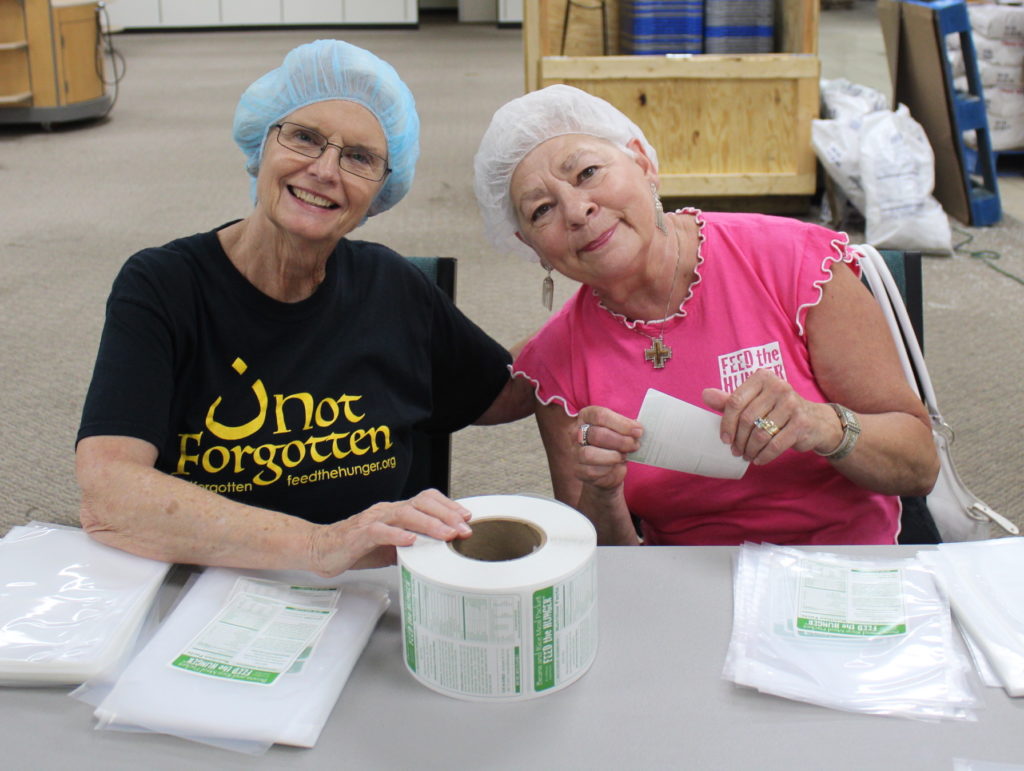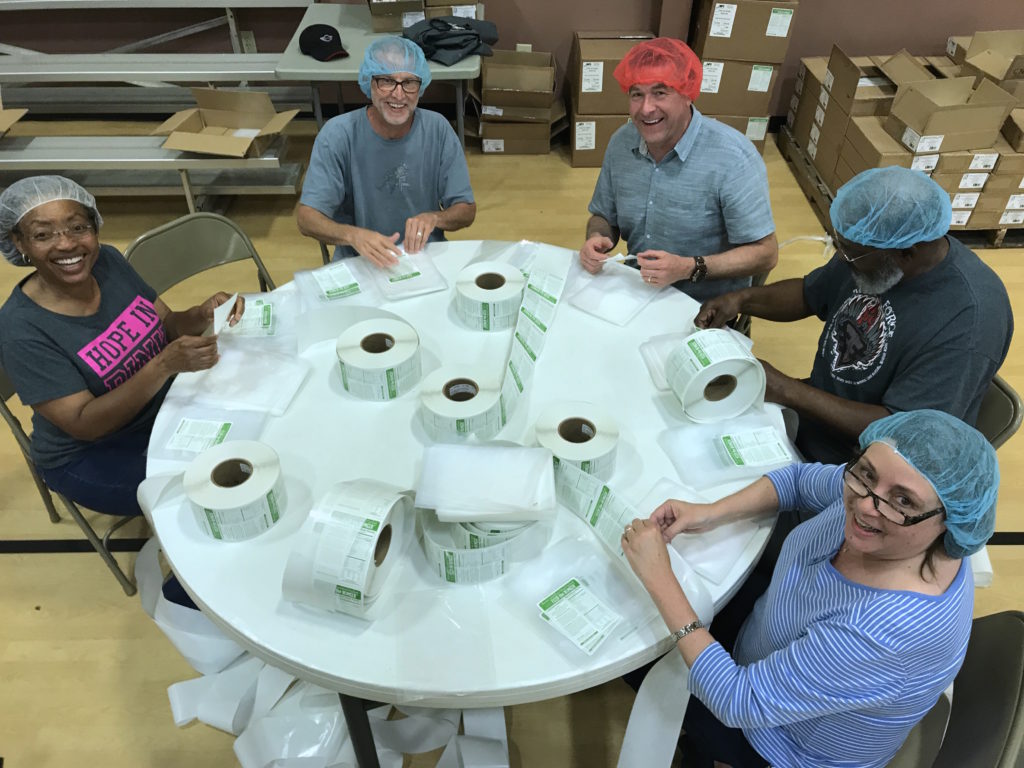I’ve got a riddle for you: What’s green and white and gets stuck thousands of times during a Packathon? If you’ve been to one of these events, you probably know the answer . . . a Feed the Hunger Beans and Rice label! Yes, I’m speaking of the small, yet powerfully sticky component of a complete FtH food bag, applied at the imaginatively named “Label Table.”
 You might have noticed the label table tucked away in the corner of a busy church gymnasium, perhaps next to a few thousand pounds of rice or beside a stack of empty boxes. During the controlled chaos of a Packathon, the labelers seem to be in their own little world, deep in conversation and focused solely on the process: peel a label, stick it on a bag, stack the labeled bag, repeat (and repeat, and repeat . . . ). But if you haven’t been a member of the label table, then you’ve missed out on a unique part of the Packathon.
You might have noticed the label table tucked away in the corner of a busy church gymnasium, perhaps next to a few thousand pounds of rice or beside a stack of empty boxes. During the controlled chaos of a Packathon, the labelers seem to be in their own little world, deep in conversation and focused solely on the process: peel a label, stick it on a bag, stack the labeled bag, repeat (and repeat, and repeat . . . ). But if you haven’t been a member of the label table, then you’ve missed out on a unique part of the Packathon.
At the label table, specifically set up for those who need or prefer a sit-down job, the faithful labelers aren’t slinging rice or sealing bags at breakneck speed—although that’s lots of fun—no, they see the event from a different perspective. You see, at the label table, conversations often run for an hour or more, and frequently get deep. Given enough time, even those from vastly different backgrounds find commonalities with each other. They might have attended the same school, or know the same person at a church, or like the same song on the playlist (sometimes, they might even belt out a few lines!).
I’ve had the privilege of being at many label tables, and it’s been an education each time. Several fellow labelers have asked insightful (often pointed) questions about Feed the Hunger, questions that should be asked about any ministry looking for partners (our last blog covered this in greater detail—read it here). I’ve been asked things like:
 How does Feed the Hunger possibly put a serving of food together for 28 cents? Buy in bulk and get lots of people together to pack. I can remind the person who asked the question that their volunteer labor helps us produce meals inexpensively.
How does Feed the Hunger possibly put a serving of food together for 28 cents? Buy in bulk and get lots of people together to pack. I can remind the person who asked the question that their volunteer labor helps us produce meals inexpensively.
Why don’t you just buy labeled bags? It costs more and, besides, it lets us open up the Packathon to people of every ability.
How many Feed the Hunger locations are there? Just one—our world headquarters and warehouse are in Graham, NC. That allows us to oversee the whole process, from ingredients to final distribution.
Why can’t you purchase rice and beans in the destination country and save a bunch of money? That’s possible in some locations where we can’t ship food, but it’s not ideal because there is little quality control and the children don’t get the vitamins and nutrients in our fortified meal packets.
Does this food actually make a difference? Definitely. Most of our meal packets are prepared in a school setting; we’ve seen for ourselves and have heard from teachers that children who routinely eat our food do better in school, miss fewer days, and develop at a more normal rate.
And the best question, How do you know the food really gets where it’s sent? Today, especially in other countries, it is common for food, aid, and other supplies to “disappear” along the way. The best way to see that the food you pack makes it to hungry mouths is to go there with us and prepare some! We frequently travel to visit our domestic and international partners, often with a few brave souls who helped pack the very food eaten at those locations. Join us!
 All these questions that arise while labeling made me consider a larger one: What is Feed the Hunger’s label? How is the ministry thought of by its supporters (and by those who don’t support us)? We’re not in it for any kind of praise or accolades, but we certainly want to reflect our mission of feeding physical and spiritual hunger while giving God the glory.
All these questions that arise while labeling made me consider a larger one: What is Feed the Hunger’s label? How is the ministry thought of by its supporters (and by those who don’t support us)? We’re not in it for any kind of praise or accolades, but we certainly want to reflect our mission of feeding physical and spiritual hunger while giving God the glory.
Then I thought, what is my label? What is yours?
Everyone has a label—a defining characteristic that describes your life and purpose. If you had to wear a nametag, what would be written on it? Would it say “Hardworking”? Perhaps it would say “Dedicated” or simply “Good.” But what if it said “Selfish” or “Unhappy”? It could say many things, some positive, some negative, but there is only one thing it could say that would save you: “Jesus-Follower.” So, to get back to the title of this post, what does your “label” say?
Matthew Byrd | Ministry Advancement Team
